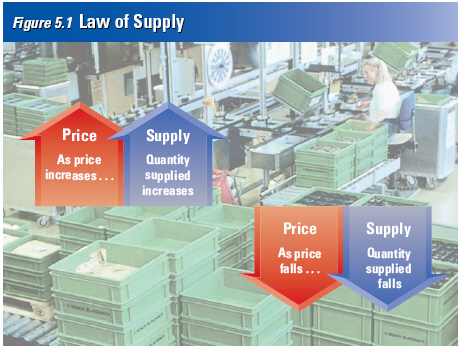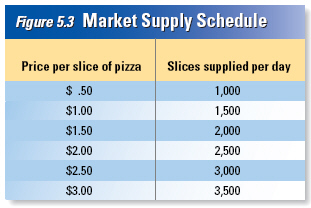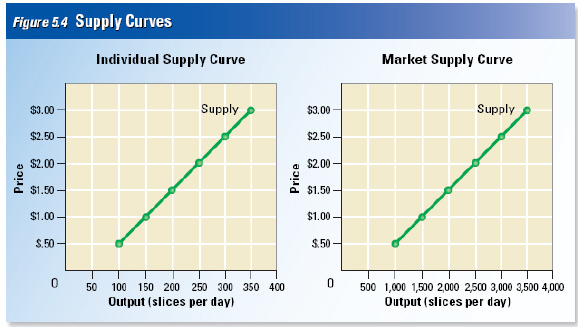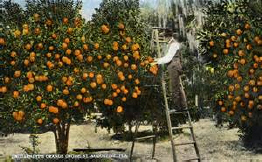|
|
|
|
|
|
1.
|
Examine the information above.
What do you expect to learn in this lesson? Enter your answer in the space on the right.
Review
the vocabulary words for this section. Look for them as we work through this section. You will be
tested on them later
|
|
|

The law of
supply predicts that higher prices lead to more production.
The Law of Supply
Supply is the amount of goods available.
How do
producers decide how much to
supply? According to the law of supply, the
higher the
price, the larger the quantity
produced. Economists use the term quantity
supplied to
describe how much of a good is
offered for sale at a specific price.
The law of supply
develops from the
choices of both current and new
producers of a good. As the price of
a
good rises, existing firms will produce
more in order to earn additional
revenue.
|
At the same time, new firms will have an
incentive to enter the market
to earn a
profit for themselves. If the price of a good
falls, some firms will produce less,
and
others might drop out of the market. These two movements—individual firms
changing
their level of production and
firms entering or exiting the market—
combine to create the
law of supply. | | |
|
|
|
2.
|
What does the law of supply
predict?
a. | higher prices will lead to less
production | c. | more supply will
lead to higher prices | b. | higher prices will lead to more production | d. | supply has no effect on production or
demand |
|
|
|
3.
|
How is the law of supply
different from the law of demand?
a. | An increase in price equals an
increase in supply and a decrease in demand | c. | A decrease in price equals an increase in supply and a decrease in
demand | b. | An increase price equals a decrease in supply and
demand | d. | There is no difference in the law of supply and
demand |
|
|
|
4.
|
What term do economists use to
describe how much of a good is offered for sale at a specific price?
a. | price
ratio | c. | quantity
demanded | b. | price demanded | d. | quantity supplied |
|
|
|
5.
|
Why do firms produce more when
prices rise?
a. | They want to share their
wealth | c. | They want to earn more
money | b. | They want to make prices fall | d. | They do not want to overproduce |
|
|
|
Higher
Production
If a firm
is already earning a profit by
selling a good, then an increase in the
price—ceteris
paribus—will increase the firm’s profits. The promise of higher revenues for each
sale also encourages the firm to produce more. Consider the pizzeria you read about in Chapter 4. The
pizzeria is probably making a reasonable profit by selling a certain number of slices a day at the
market price. If the pizzeria weren’t making a profit, the owner would soon try to raise the
price or switch from pizzas to something more profitable.
If the price of pizza rises, but the
firm’s cost of making pizza stays the same, then the pizzeria will earn a higher profit on each
slice of pizza. A sensible entrepreneur would try to produce and sell more pizza to take advantage of
the higher prices.
| Similarly, if the price of pizza goes down, the pizzeria will earn less profit
per slice or even lose money. The owner will choose to sell less pizza and produce something
else, such as calzones or sandwiches, that will yield more profit.
In both cases, the search
for profit drives the supplier’s decision. When the price goes up, the supplier recognizes the
chance to make more money and works harder to produce more pizza. When the price falls, the same
entrepreneur is discouraged from producing as much as before.
| | |
|
|
|
6.
|
If a company were selling a
product and suddenly the price of the product increased, what action would the company likely
take?
a. | They would decrease supply to
increase demand | c. | They would produce
less of the product (decrease supply) | b. | They would produce more to lower the price | d. | They would produce more of the product (increase
supply) |
|
|
|
7.
|
What motivation drives the
behavior of business persons?
a. | taking less
risk | c. | making more
money | b. | taking more risk | d. | increasing price |
|
|
|
Market
Entry
Profits appeal
both to producers already in
the market and people who may decide to
join the market. As you
have seen, when
the price of pizza rises, a pizzeria stands out
as a good opportunity to make
money. If
you were considering opening a restaurant
of your own, a pizzeria would look like
a
safe bet. In this way, rising prices draw new
firms into a market and add to the
quantity
supplied of the good.
Consider the market for music. In the
late 1970s, disco
music became popular
among young people. The music industry
quickly recognized the popularity
of disco,
and more and more groups began releasing
disco recordings. Even some groups
that
once performed soul music and rhythm
and blues chose to record disco albums.
New
entrants crowded the market to take
advantage of the potential for profit. Disco,
however,
proved to be a short-lived fad. By
the early 1980s, disco music was gone from
the radio, and
stores couldn’t sell the
albums on their shelves.
This pattern of sharp increases
and
decreases in supply occurs again and again
in the music industry. In the early
1990s,
“grunge” music emerged from Seattle to
become widely popular among high
school
and college students across the country.
How did the market react? Record labels
soon
hired many grunge groups. Music
stores devoted more and more space to this
style of music.
Within a few years,
however, grunge lost its appeal, and many
groups disbanded or moved on to
new
styles. Other styles of music, such as salsa,
achieved new
popularity.
|
In each of the examples above, many
musicians joined the market for
a particular
style of music to profit from a trend.
Their actions reflected the law of
supply,
which says that the output or quantity
supplied of a good increases as the price
of
the good increases.

Grunge
Fashion | | |
|
|
|
8.
|
You are a young man who has
some money and is thinking about starting a business in sporting goods. You notice that there has
been a sharp decline in the prices of bogy boards and skate boards, while the price of surf
boards has remained about the same. You also notice that there has been a rise in the price of snow
boards over the past year. Since your goal is to make lots of profits, which item are your likely to
feature in your new sporting goods store?
a. | bogy
boards | c. | snow
boards | b. | surf boards | d. | skate boards |
|
|
|
9.
|
In the discussion above, what
do we learn about music?
a. | Young people can’t make up
their minds about the type of music they like. | c. | Musicians tend to play the most popular form of music because like any other
business person they want to make money | b. | It is better to become a classical musician because classical music is always
with us. | d. | Hip Hop, Disco, Grunge, Rap, Rhythm
and Blues, and Heavy Metal are not good forms of music because their popularity does not
last |
|
|
|
This supply schedule lists how many slices of pizza one
pizzeria will offer at different prices.
The Supply
Schedule
Similar to a
demand schedule, a supply
schedule shows the relationship between
price and quantity
supplied for a specific
good. The pizzeria discussed earlier might
have a supply schedule that
looks like the
one in Figure 5.2. This table compares two
variables, or factors that can
change. These
variables are the price of a slice and the
number of slices supplied by a
pizzeria. We
could collect this information by asking the
pizzeria owner how many slices she
is
willing and able to make at different prices,
or we could look at records to see how
the
quantity supplied has varied as the price
has changed. We will almost certainly
find
that at higher prices, the pizzeria owner is
willing to make more pizza. At a
lower
price she prefers to make less pizza and to
devote her limited resources to other,
more
profitable, items.
|
Like a demand schedule, a supply
schedule lists
supply for a very specific set
of conditions. The schedule shows how the
price of pizza, and
only the price of pizza,
affects the pizzeria’s output. All of the other
factors that
could change the restaurant’s
output decisions, such as the costs of tomato sauce, labor,
and rent, are assumed
to remain constant.
| | |
|
|
|
10.
|
What does this chart tell you
about the pizzeria owner’s decisions?
a. | He will produce more slices as the
price increases. | c. | He will make the
same amount of money no matter what the price is | b. | He will produce fewer slices as the price
increases | d. | Pizza restaurant owners are not good
business people |
|
|
|
11.
|
Many factors can influence the
supply of pizza. The supply schedule shows only one factor. What is it?
a. | cost of tomato
sauce | c. | rent | b. | labor | d. | price of pizza
|
|
|
|
A Change in the Quantity
Supplied
Economists use
the word supply to refer to
the relationship between price and quantity
supplied, as
shown in the supply schedule.
The pizzeria’s supply of pizza includes all
possible
combinations of price and output.
According to this supply schedule, the
pizzeria’s
supply is 100 slices at $ .50 a
slice, 150 slices at $1.00 a slice, 200 slices
at $1.50 a
slice, and so on. The number of
slices that the pizzeria offers at a specific
price is called
the quantity supplied at that
price. At $2.50 per slice, the pizzeria’s
quantity supplied
is 300 slices per day.
| A rise or fall in the price of pizza will
cause the quantity supplied to
change, but
not the supply schedule. In other words, a
change in a good’s price moves the
seller
from one row to another in the same
supply schedule, but does not change the
supply
schedule itself. When a factor other
than the price of pizza affects output, we
have to build a
whole new supply schedule
for the new market conditions. | | |
|
|
|
12.
|
What do we call the number of
slices of pizza at a specific price?
a. | supply
demanded | c. | quantity
demanded | b. | quantity supplied | d. | ratio of price to demand |
|
|
|
13.
|
What does the economist have to
do when a factor other than the price of pizza affects output?
a. | go back and rely on
demand | c. | nothing can affect supply other than
price | b. | build a new supply schedule for the new
condition | d. | divide the price by the supply times
100 and create a new schedule |
|
|
|

A market supply schedule represents all
suppliers in a market.
Market Supply Schedule
All of the supply schedules of individual
firms in a
market can be added up to create
a market supply schedule. A market supply
schedule
shows the relationship between
prices and the total quantity supplied by all firms in a particular
market. The information
in a market supply schedule becomes
important when we want to determine
the
total supply of pizza at a certain price in a
large area, like a city.
The market
supply schedule for pizza
resembles the supply schedule at a single
pizzeria, but the
quantities are much larger.
Figure 5.3 shows the supply of pizza for a
hypothetical
city.
This market supply schedule lists the
same prices as those in the supply
schedule
for the single pizzeria, since all restaurants
will charge prices within the same
range.
The quantities supplied are much larger
because there are many pizzerias in
the
community. Like the individual supply
schedule, this market supply schedule
reflects the
law of supply. Pizzerias supply
more pizza at higher prices.
| | | |
|
|
|
14.
|
In figure 5.2 you saw the
supply schedule for an individual pizzeria, such as Little Caesar’s. What if you wanted to
create a supply schedule for all of the Little Caesar’s in San Diego? What would we call that
new supply schedule for an entire city?
a. | market supply
schedule | c. | supply vs price
schedule | b. | supply schedule | d. | demand schedule |
|
|
|
15.
|
In figure 5.2 you saw the
supply schedule for an individual pizzeria, such as Little Caesar’s. What if you wanted to
create a supply schedule for all of the Little Caesar’s in San Diego? How would this new supply
schedule for a city differ from an individual Little Caesar’s store?
a. | The quantities supplied would be
much larger | c. | The prices would
be much larger | b. | The quantities demanded would be much larger | d. | The prices would be much smaller |
|
|
|
 Supply curves always rise from left to right, as predicted by the law of supply. As price
increases, so does the quantity supplied. Supply curves always rise from left to right, as predicted by the law of supply. As price
increases, so does the quantity supplied.
The
Supply Graph
When
the data points in the supply
schedule are graphed, they create a supply
curve. A supply
curve is very similar to a
demand curve, except that the horizontal
axis now measures the
quantity of the good
supplied, not the quantity demanded.
Figure 5.4 shows a supply curve for
one
pizzeria and a market supply curve for all the pizzerias in the city. The data used to
draw the two curves are from the supply schedules in Figures 5.2 and 5.3. The prices
| shown
along the vertical axes are the same
in both graphs. However, the quantities of
pizza supplied
at each price are much larger
in the market supply curve.
The key feature of the supply
curve is
that it always rises from left to right. As
your finger traces the curve from left
to
right, it moves toward higher and higher
output levels (on the horizontal axis)
and
higher and higher prices (on the vertical
axis). This illustrates the law of
supply,
which says that a higher price leads to
higher output. | | |
|
|
|
16.
|
Why do supply curves always
rise from left to right.
a. | because price and quantity supplied
rise together | c. | because supply and
demand fall together | b. | because price rises while supplies fall | d. | because supplies rise while price
falls |
|
|
|
17.
|
In a supply curve the
horizontal axis measures _____ while in a demand curve the horizontal axis measures _____
.
a. | supply -
supply | c. | supply -
demand | b. | demand - demand | d. | demand - supply |
|
|
|
Supply and
Elasticity
In Chapter 4,
you learned that elasticity of
demand measures how consumers will
react to a change in price.
Elasticity of supply is based on the same concept. Elasticity of supply is a measure of
the way suppliers respond to a change in price.
Elasticity of supply tells how firms will
respond to changes in the price of a good. The labels elastic, inelastic, and unitary
elastic represent the same values of elasticity of supply as those of elasticity of
demand.
|
When elasticity is greater than one, supply is very sensitive to changes
in price and is considered elastic. If supply is not very responsive to changes in price, and
elasticity is less than one, supply is considered inelastic. When a percentage change in price is
perfectly matched by an equal percentage change in quantity supplied, elasticity is exactly one, and
supply is unitary elastic. | | |
|
|
|
18.
|
What does elasticity of supply
measure?
a. | how suppliers respond to a change in
demand | c. | how demand affects
price | b. | how suppliers respond to a change in price | d. | how consumers react to a change in
supply |
|
|
|
19.
|
Elastic, inelastic,
and unitary elastic
represent the same values of elasticity of supply as those of elasticity of
demand.
|
|
|
20.
|
When a percentage change in
price is perfectly matched by an equal percentage change in quantity supplied, elasticity is exactly
one and supply is
a. | unitary
elastic | c. | inelastic | b. | elastic |
|
|
|
21.
|
If supply is not very
responsive to changes in price, and elasticity is less than one, supply is considered
a. | elastic | c. | unitary elastic | b. | inelastic |
|
|
|
22.
|
When elasticity is greater than
one, supply is very sensitive to changes in price and is considered
a. | elastic | c. | unitary elastic | b. | inelastic |
|
|
|
Elasticity of Supply and Time
What determines whether the supply of a good will be
elastic or inelastic? The key factor is time. In the short run, a firm cannot easily change its
output level, so supply is inelastic. In the long run, firms are more flexible, so supply is more
elastic.
Elasticity
of Supply in the Short Run
An orange grove is one example of a
business that has difficulty adjusting to
a
change in price in the short term. Orange
trees take several years to mature and grow fruit.
If the price of oranges goes up, an
orange grower can buy and plant more
trees, but he will
have to wait several years
for his investment to pay off. In the short
term, the grower could
take smaller steps
to increase output. For example, he could
use a more effective pesticide.
While this
step might increase his output somewhat, it
would probably not increase the number
of
oranges by very much. Economists would
say that his supply is inelastic, because
he
cannot easily change his output. The same
factors that prevent the owner of the
orange
grove from expanding his supply
will also prevent new growers from
entering the market and
supplying oranges
in the short term.
In the short run, supply is inelastic
whether the
price increases or decreases. If
the price of a crate of oranges falls, the
grove owner has few
ways to cut his supply.
He invested years ago in land and trees, and
his grove will provide
oranges no matter
what the price is. Even if the price drops
drastically, the grove owner will
probably
pick and sell nearly as many oranges as
before. The grove owner’s competitors
have
also invested heavily in land and trees and
won’t drop out of the market if they
can
survive. In this case, supply is inelastic
whether prices rise or fall.
|
While orange groves illustrate a business
in which supply is inelastic,
other businesses
benefit from more elastic supply.
For example, a business that provides
a
service, such as a haircut, is highly elastic.
Unlike oranges, the supply of haircuts
is
easily expanded or reduced. If the price
rises, barber shops and salons can hire
workers
quickly.
In addition, new barber shops and
salons will open, and existing
businesses
might stay open later in the evening. This
means that a small increase in price will
cause a large increase in quantity supplied,
even in the short term.
If the price of a
haircut drops, some
barbers will close their shops earlier in the
day, and others will leave
the market for
jobs elsewhere. Quantity supplied will fall
quickly. Because haircut suppliers
can
quickly change their operations, the supply
of haircuts is elastic.
 | | |
|
|
|
23.
|
What is the key factor that
determines if the supply of a good will be elastic or inelastic?
a. | supply | c. | time | b. | demand | d. | substitutes |
|
|
|
24.
|
Because companies can’t
easily change production quickly, supply is
a. | elastic | c. | varied | b. | inelastic | d. | costly |
|
|
|
25.
|
When companies have more time
to change production, supply becomes more
a. | elastic | c. | plentiful | b. | inelastic | d. | costly |
|
|
|
26.
|
In the short run, automobile
factories tend to be _____ while donut shops tend to be _____ .
a. | inelastic -
elastic | c. | inelastic -
inelastic | b. | elastic -inelastic | d. | elastic - elastic |
|
|
|
Elasticity
in the Long Run
Like
demand, supply can become more
elastic over time. Consider the example of
the orange grower who
could not increase
his output much when the price of oranges
rose. Over time, he could plant
more trees
to increase his supply of oranges. These
changes will become more effective
over
time as trees grow and bear fruit. After
several years, he will be able to sell
many
more oranges at the high market price.
|
If the price drops and stays low
for
several years, orange growers who survived
the first two or three years of losses
might
decide to give up and grow something else.
Given five years to respond instead of
six
weeks, the supply of oranges will be far
more elastic. Just like demand, supply
becomes
more elastic if the supplier has a
long time to respond to a price
change. | | |
|
|
|
27.
|
When companies have enough time
to change their production demand and supply can become
a. | inelastic | c. | more costly | b. | elastic | d. | more scarce |
|
|
|
|
|
|
28.
|
If supply is inelastic, how
will supply react to a small increase in price?
a. | there will be a big change in
supply | c. | supply will change but very
little | b. | supply will not change at all | d. | price has no effect on supply |
|
|
|
29.
|
Which two actions, taken by
firms comprise the law of supply? (pick 2)
|
|
|
a. | quantity
supplied | f. | variable | b. | market supply schedule | g. | market supply curve | c. | supply | h. | supply schedule | d. | elasticity of supply | i. | supply curve | e. | law of supply |
|
|
|
30.
|
a chart that lists how much of a good a supplier will
offer at different prices
|
|
|
31.
|
the amount a supplier is willing and able to supply at
a certain price
|
|
|
32.
|
a graph of the quantity supplied of a good by all
suppliers at different prices
|
|
|
33.
|
the amount of goods available
|
|
|
34.
|
a measure of the way quantity supplied reacts to a
change in price
|
|
|
35.
|
tendency of suppliers to
offer more of a good at a higher price
|
|
|
36.
|
a graph of the quantity supplied of a good at different
prices
|
|
|
37.
|
a factor that can change
|
|
|
38.
|
a chart that lists how much
of a good all suppliers will offer at different prices
|